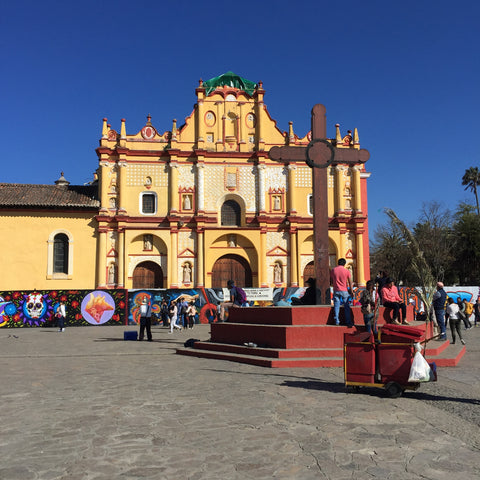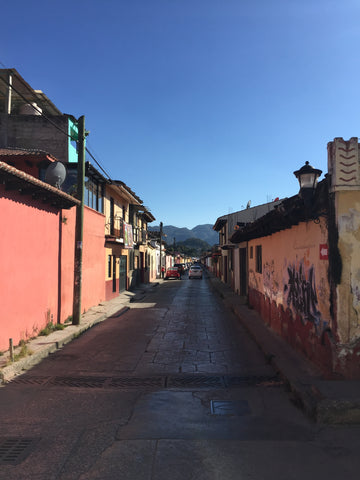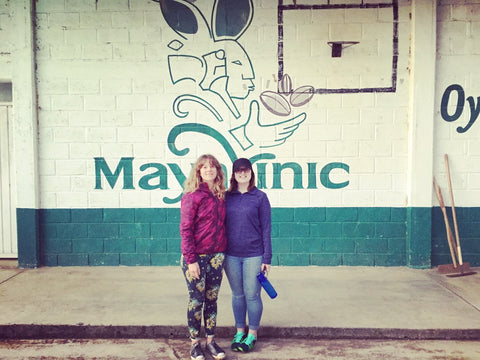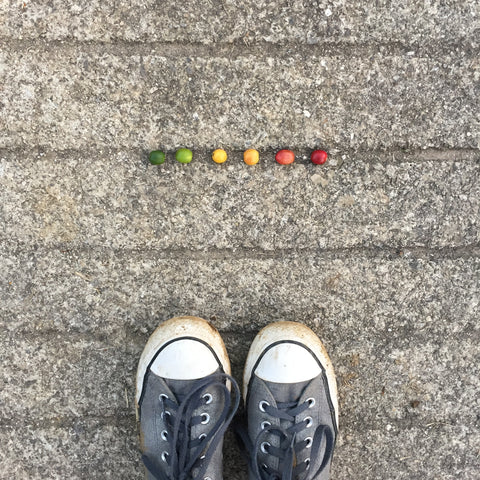
When the opportunity arrived to travel with a delegation to our producer partner in Chiapas, Mexico, Maya Vinic, it was perfect timing. Just as the coffee trees were turing ripe with red cherries the winter cold snap was setting in hard and fast in New England. Traveling with me would be Kasi Billings who has worked for us more than 1 1/2 years as barista and trainer. This was her first time out of country so we expedited her passport and it landed a week later.
Our air tickets took us to Tuxtla Gutiérrez, the capital of Chiapas. Then by car we traveled 1 hour up into the highlands to a town called San Cristobal, altitude of 7,000 feet. Upon entering San Cristobal you could feel the old colonial buildings and streets. The bright pastels painted all over town structures was an immediate delight.
There is so much to say about this journey but Kasi and I felt it could be best discussed through a series of questions we both answered. We hope you enjoy. [pictures at the end]
This coffee delegation to Chiapas, Mexico was your first time out of the country. What stands out the most in your travels?
Kasi: Not only did I get to learn about coffee on this trip, I learned about the kindness that was shared. Every single person I met was so unbelievably nice and welcoming which was such a good change of pace given the hostile environment between America and Mexico. The generosity and gratitude I witnessed will forever hold a place in my heart.
Why is it important for coffee shop owners and employees to travel to the origin of where their coffee is produced?
Kasi: Traveling to origin was a very important thing for me as an employee, as I am sure it was equally important to Melissa. I have learned a plethora of knowledge on green coffee, the roast process and the brewing methods in the last few years but had yet to experience the agronomy side of coffee and to also see / taste a coffee cherry. The most important part of this experience was getting to meet the farmers. The farmers are really who help make this product such a great commodity. I witnessed so much passion and commitment from making sure the coffee was grown the most organic way they could possibly do it to expelling the whole growing process to complete strangers.
Melissa: When I review our accouting reports of costs of goods sold, it is beyond clear that our raw product — green coffee — is single handedly the largest expense in our company. From the beginning, it has been extremely important to us where this money goes in both an ethical and environmental impact sense. Traveling to origin provided both proof and reassurance that our money is going to supporting coffee families and communities who are being empowered to make choices that suit the whole person, the whole community, not just the immediate need for cash. The whole person in Maya Vinic Co-op is a group of indigenous farmers who have worked their plots of land for many generations. The land is healthy and capable of growing other cash crops in addition to coffee. The whole person is healthier without having to use pesticides to support continued coffee growth. The whole person is empowered in finding solutions to agricultural challenges, such as leaf rust or El Roya, that call on local knowledge and materials instead of imported products and treatments. In our travels to Chiapas we were able to witness all of this. By listening to the coffee board of Maya Vinic, farmers and “technicos,” we learned of stories that dealt with current farm politics and challenges, solutions to these situations, and future anticipation of hardships. Our interest reassured the coffee farmers that the relationship was a collective partnership and not just a one-way transaction.
Do you feel differently about Maya Vinic coffee now that you have met some of the individuals who are involved in the co-op?
Kasi: I hadn’t done much research on Maya Vinic prior to this trip but I can say, I never expected to see just how much effort goes into this product we all get to roast and brew daily. Meeting the owners and others who are involved with the cooperative was such a cool experience. Each person had their own connection to why growing coffee was important and each person did a fantastic job explaining that.
Melissa: Yes! I have utmost respect for the labor involved in picking coffee in such mountainous terrain. The logistical challenges of picking, pulping, and patio drying coffee beans (done by individual families first) then transporting them to the co-op’s centralized processing mill seemed intense on both a physical plane and also political sphere. I learned a great deal surrounding Chiapas politics. Zapatista communities are in constant threat of larger Mexican government knocking on their door. At first to offer community services — schools, health centers, community spaces — but later assuming access to land for resource extraction such as oil, natural materials, etc.The resistance is very much alive and it is visible daily as we saw on a mid-week road block that made us travel 4 hours out of the way back to San Cristobal.
How would you describe the life of a coffee farmer in rural Mexico to a 44 North customer?
Kasi: It is not a glamorous job by any means. The amount of sweat and tears I saw being put into the work these farmers are doing was incredible. It gave me a whole new appreciation for the product our shop gets to work with everyday. There is a much longer line of process besides what you see here in the shop. For these farmers, it is the best way to supply for their families.
Melissa: I am thinking in terms of energy output to answer this question. Coffee farming in rural mountainous conditions is extremely time consuming with logistics up and down the mountain, monitoring of seasonal differences in harvest from year to year, and crop health security. The amount of physical labor that goes into planting seeds in the coffee nursery, creating the correct balance of nutrient rich compost, planting trees, picking coffee cherries once the trees mature, addressing bacterial infections, and doing the same thing all over again once the trees retire, must be constant in a farmer's thought process.
And all while working in coffee, there are families to raise and provide for, educate, and local politics that one cannot escape. As an outsider I view it as a somewhat exhausting life that cannot yield that much income, but I also witnessed beautiful moments of families and communities in total union, strong communication around moving parts, and pride.
What struggles became visible to you surrounding coffee farming in indigenous communities that you were previously unaware of?
Kasi: Again, I hadn’t done much research before I left but as soon as I got there, I realized how many political problems these farmers were having with the para-military and “government.” One important piece of this that I feel I should point out is a school called Cideci. This school has been helping young men and women in Mexico who live in the surrounding indigenous communities attend a school for free. The only repayment asked is to take what they learn back to their communities. This is a good example because this school has received plenty of threats from the government and the government did follow through with that at one point. The school needs electricity to run and the government knew that so to show they weren’t bluffing, they cut their power. Cideci retaliated and got the largest generator possible to run the entire campus. This school has over 20 workshops and has on campus housing or students can attend daily or go home at night. This school is a great example of the resistance happening in Mexico. There is much more going on than is publicized.
Melissa: The struggle to exist independently and the resistance to larger government support (due to a belief among some indigenous people that the government has a negative agenda) was a new concept for me to understand. One of the largest examples can be found in the acceptance of NAFTA -- North American Free Trade Agreement -- on January 1, 1994 under the Clinton administration. This agreement removed tariffs and barriers to trade between USA / Mexico / and Canada. While trade between nations increased drastically, the impact on small scale Mexican farmers was hugely significant, making it impossible for them to compete with larger agribusinesses. Overnight, American corn -- the staple of the Mexican diet -- was cheaper to import and feed the country than sourcing from within. And as we all know, with mega agribusiness comes less crop varietals = less flavor and more GMO's. Poverty was extremely evident in many of the communities we visited and I cannot help but think that from 1994 onward it has only gotten worse.
Last but not least, what was your favorite part of the trip?
Kasi: My favorite part of this trip was the culture and color Mexico has. I have never seen so much color or beautiful artwork in my entire life. I learned so much for it being my first international trip and I am so thankful I got to travel with Melissa and be better informed on the green side of coffee. This trip will forever hold a special place in my heart.
Melissa: So many highlights but my biggest highlight was traveling with our employee, Kasi. She accepted the idea of travel immediately, saw to expediting her passport, and approached the journey in a beautiful way. Towards the end, she also supported me in one of the more wicked bouts of food sickness and that meant a great deal.
Other highlights included the people we encountered and the colors of San Cristobal! Our driver / in-country guide, Julio, was simply the best. He spoke in poetic form and you could sense all the emotion and depth of his experience growing up in Chiapas. He was a true asset for our coffee delegation, not to mention the fellow coffee people we traveled with from the USA -- Becky from Cooperative Coffee [Georgia], Craig and Laura from Conscious Coffees [Colorado], Katie from River Rock Cafe [Minnesota], Bobbi from Kickapoo Coffee [Wisconsin], Dan from Amavida Coffee [Florida], Nick from OTG, Simon and Trisja, and Chandler.

[Cathedral of San Cristobal de las Casas]

[Pastel painted streets of San Cristobal de las Casas]

[Mel and Kasi at the centralized coffee processing mill for Maya Vinic]
[
[Kasi - "toastador" is the Spanish word for roaster!]

[Various stages of coffee ripening]

[Just a wee walk through the coffee lands...although not certified, this coffee is definitely shade grown!]

[Kasi preparing to plant her first coffee tree at the Maya Vinic nursery]

[A technico explaining the importance of tree health before it is placed into the ground]

[The coffee that we purchase, "resting" before being sorted and placed into burlap]

[Our group! roasters and cafe owners across the USA who have come to see Maya Vinic]

[Soccer / futbol! the universal language of "peace"]

[Church with coffee drying in the community of Acteal, Chiapas. This small community is known for the devastating massacre of 45 people in 1997 by a neighboring para-military group. You can learn more here.]

[Mel and Kasi outside the music workshop and library at CIDECI -- a school and residence for indigenous peoples free of charge with offerings of more than 20+ workshops including everything from electricity to ceramics to baking. This school operates outside of any government support, including refusing to be on San Cristobal power grid and instead on their own self funded generator.]

[Plant wall at CIDECI]

[The streets of San Cristobal, full of color and VW's!]


Leave a comment